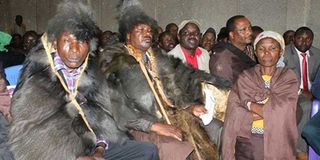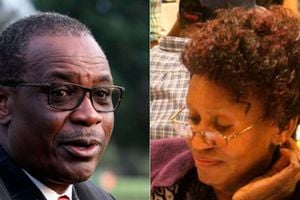Visit disputed Mau land before writing report, taskforce told

Members of the Ogiek community follow proceedings in Nakuru Town on February 6, 2019 during a meeting of the taskforce on the implementation of the decision of the African Court on Human and People's rights on their occupation of Mau Forest land. A group has urged the taskforce to visit the contested parcels of land before preparing a final report. PHOTO | JOHN NJOROGE | NATION MEDIA GROUP
What you need to know:
- The group claims that the Ogiek sold them the parcels of land they own while some were allocated to them by the government.
- Mr Kibiegon explained that in 1995, the government allocated people areas gazetted for purposes of settling landless communities.
- The taskforce was also to study other judgments issued by local courts in relation to the occupation of the Mau Forest by the Ogiek.
A group has urged a taskforce appointed to implement a decision of the African Court on the Ogiek community’s land rights in Mau Forest to visit the contested parcels of land before preparing a final report.
Nakebba Community Based Organisation wants the 17-member taskforce formed by Forestry Cabinet Secretary Keriako Tobiko in March 2018 to go to the grassroots to determine whether the land claimed by the Ogiek was grabbed or rightfully sold to them.
“If they want to know the truth, let them not just sit in hotels but let them come to the ground and interview people so that the real facts can come out,” said Peter Kibiegon, the chairman of the group.
OGIEK SOLD LAND
The group, comprising of more than 10,000 members, claims that the Ogiek sold them the parcels of land they own while some were allocated to them by the government as early as 1995.
Mr Kibiegon explained that in 1995, the government allocated people from Tinet plots in Sururu, Likia, Mauche, Teret and Sigotik settlement schemes areas gazetted for purposes of settling landless communities.
“Some of us were legally allocated five-acre plots by the government while majority bought their parcels of lands from the Ndorobos (Ogiek),” he said.
RIGHTS VIOLATED
In March 2017, the African Court on Human and Peoples' Rights ruled that the Kenyan government had violated the rights and freedoms of the Ogiek people by driving them out of their ancestral lands.
The court based in Arusha, Tanzania ordered the government "to take all appropriate measures within a reasonable time frame to remedy all the violations established and to inform the court of the measures taken within six months from the date of this judgment".
SETTLEMENT SCHEME
However, Mr Kibiegon disputed that the land was a community land, saying that it is a settlement scheme that was divided into two by the government – 60 percent given to the Ogiek while the remaining 40 percent was given to the other communities who had moved into the area following ethnic clashes.
“It is a settlement scheme where the inhabitants (Ogiek) were given the bulk of the land. They later sold the land and went to the forest but when a law was enforced for people to move out, they came back claiming the same parcels they had sold,” Mr Kibiegon said Friday.
He called for the process to be expedited to avert further clashes between the Ogiek and the other communities living in the area, adding that since the Arusha court ruling, three clashes that have led to loss of lives and properties have been witnessed.
DOCUMENTS
“We do not want to lose more lives and properties as we have in the past as they maintain that they must be given the lands they had sold [yet] we even have relevant documents to that effect,” he said.
The taskforce was also to study other judgments issued by local courts in relation to the occupation of the Mau Forest by the Ogiek, conduct studies and public awareness on the rights of indigenous people and also get views of the members of the public and any interest groups alongside seeking expert advice from consultants.
The team was also to recommend measures to provide redress to the claims of the community, which may include return to their original land or compensation with alternative land.
It was then to prepare interim and final reports to be submitted to the African Court on Human and Peoples Rights in Arusha Tanzania and examine the effects of the Judgment on other similar cases in other areas of the country.





